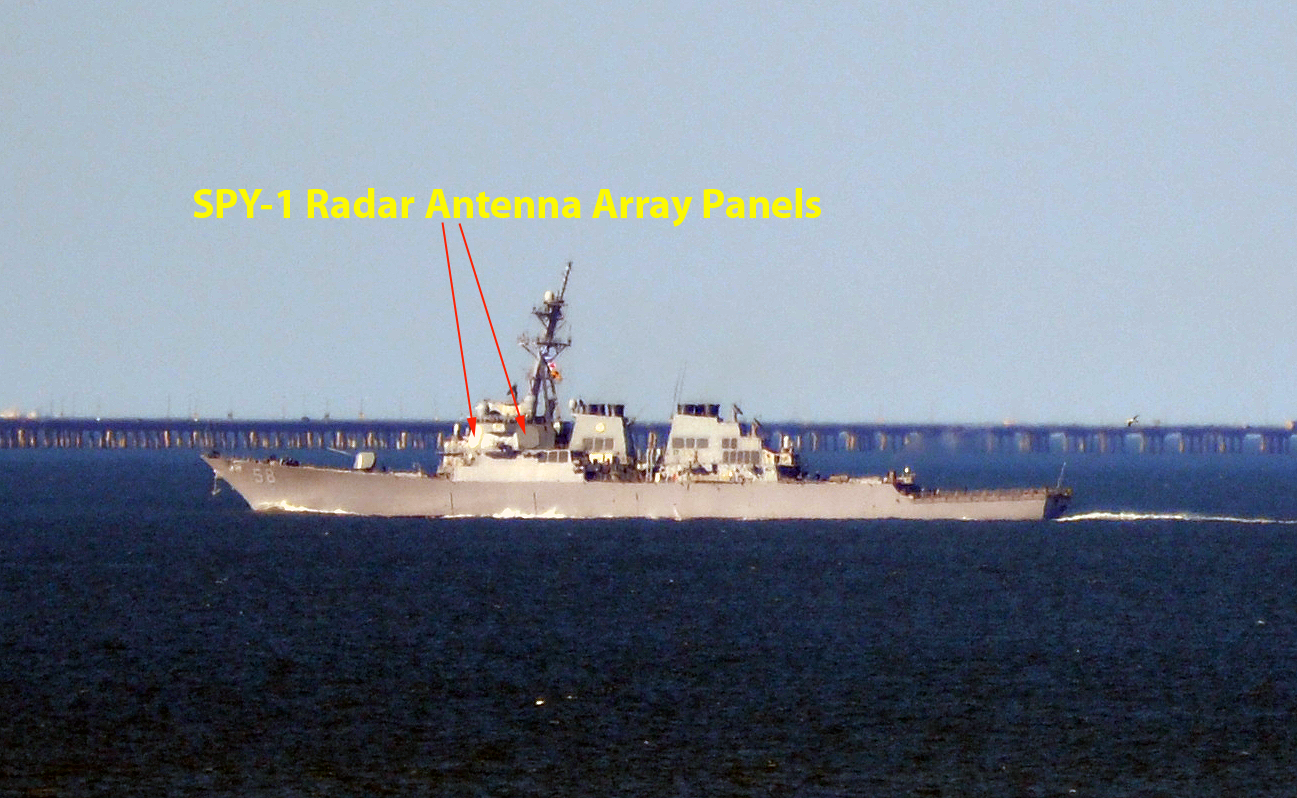| |
|
|
|
SPY-1 Shipborne Air Surveillance Radar
|
The SPY-1 is a U.S. Navy phased array surveillance radar that is a component of the Aegis combat system. It is installed on guided missile cruisers (CG) and guided missile destroyers (DDG). Several variants of the SPY-1, including the -1A, -1B(V), -1D, and -1F are in service, modified to fit specific types of vessels. The -1F is not installed on any U.S. ships.
U.S. land-based test and training sites for the SPY-1 are at Moorestown, NJ, and Wallops Island, VA.
The SPY-1 possesses the following technical characteristics according to ITU-R Recommendation M.1465:
-Modulation: Q7N (angle-modulated, two or more digital channels, no information transmitted)
-Tuning range: 3100-3500 MHz
-Peak tx power into antenna: 4 – 6.4 MW (66 – 68 dBW)
-Antenna gain: 42 dBi
-Peak EIRP: 63 – 101 GW (108-110 dBW)
-Pulse width: 6.4 – 51.2 microseconds
-Pulse repetition rate: 0.152-6 kHz
-Duty cycle: 0.8-2.0%
-Tx bandwidth (-3 dB): 4 MHz
-Average EIRP (=peak EIRP x duty cycle): 504 MW – 2 GW (87-93 dBW)
-Minimum effective isotropic power spectral density: 126 W/Hz (51 dBm/Hz)
-Maximum effective power isotropic spectral density: 500 W/Hz (57 dBm/Hz)
-Antenna type: Phased array
-Beamwidth: 1.7 deg (azimuth and elevation)
-Polarization: Vertical
-Antenna rotation rate: N/A (electronically steered)
The SPY-1 is known to emit very high levels of out-of-band emissions outside of the 3100-3500 MHz band.
|
Frequency Bands |
| Band | Use | Service | Table |
| 3100 - 3500 MHz | SPY-1 Shipborne Air Surveillance Radar | Radiolocation | F |
Associated Files:

SPY-1 phased array antenna panels on the guided missile destroyer USS Laboon, photographed in the Chesapeake Bay near Norfolk, Virginia.
Display this entry in a page by itself
Edit
|
|
|
|
|
|
Airport Surveillance Radar (ASR-11)
|
According to the FAA:
Airport Surveillance Radar (ASR-11) is an integrated primary and secondary radar system that has been deployed at terminal air traffic control sites. It interfaces with both legacy and digital automation systems and provides six-level national weather service calibrated weather capability that provides enhanced situational awareness for both controllers and pilots.
The primary surveillance radar uses a continually rotating antenna mounted on a tower to transmit electromagnetic waves that reflect, or backscatter, from the surface of aircraft up to 60 nautical miles from the radar. The radar system measures the time required for radar to echo to return and the direction of the signal. From this, the system can then measure the distance of the aircraft from the radar antenna and the azimuth, or direction, of the aircraft in relation to the antenna. The primary radar also provides data on six levels of rainfall intensity and operates in the range of 2700 to 2900 MHz. The transmitter generates a peak effective power of 25 kW and an average power of 2.1 kW. The average power density of the ASR-11 signal decreases with distance from the antenna. At distances of more than 43 feet from the antenna, the power density of the ASR-11 signal falls below the maximum permissible exposure levels established by the Federal Communications Commission (FCC).
The secondary surveillance radar uses a second radar beacon antenna attached to the top of the primary radar antenna to transmit and receive area aircraft data for barometric altitude, identification code, and emergency conditions. Military, commercial, and some general aviation aircraft have transponders that automatically respond to a signal from the secondary radar by reporting an identification code and altitude. The air traffic control centers uses this system data to verify the location of aircraft within a 60-mile radius of the radar site. The secondary radar also provides rapid identification of aircraft in distress. The secondary radar operates in the range of 1030 to 1090 MHz. Transmitting power ranges from 160 to 1500 watts.
|
Frequency Bands |
| Band | Use | Service | Table |
| 1030 - 1090 MHz | Airport Surveillance Radar (ASR-11) secondary radar band | Aeronautical Radionavigation | F |
| 2700 - 2900 MHz | Airport Surveillance Radar (ASR-11) primary radar band | Aeronautical Radionavigation | F |
External Links:
Display this entry in a page by itself
Edit
|
|
|
|
|
|
LeoLabs Low Earth Orbit Tracking Radars
|
LeoLabs operates S-band radars used for tracking Low Earth Orbit (LEO) satellites under an experimental license from the FCC (W02XXL). The U.S. sites are:
Kermit (WINKLER), TX - NL 31-57-53; WL 103-14-01; MOBILE: Kermit. TX, within 0.2 km, centered around NL 31-57-53; WL 103-14-01
Pearce (COCHISE), AZ - NL 31-52-16; WL 109-30-20; MOBILE: Pearce, AZ, within 0.1 km, centered around NL 31-52-16; WL 109-30-20
Magdalena (SOCORRO), NM - NL 33-43-32; WL 107-11-35; MOBILE: Magdalena, NM, within 0.2 km, centered around NL 33-43-32; WL 107-11-35
Graham Pass Rd, CA - NL 33-36-22; WL 115-02-29; MOBILE: Graham Pass Rd, CA, within 0.1 km, centered around NL 33-36-22; WL 115-02-29
LeoLabs also has experimental licenses (WO2XME and WN2XAM) for UHF radars at Pearce AZ and Kermit TX:
Pearce (COCHISE), AZ - NL 31-52-15; WL 109-30-22
Kermit (WINKLER), TX - NL 31-57-52; WL 103-14-01
LeoLabs also has S-band and UHF experimental licenses at its facilities in Menlo Park CA, and is involved in LEO tracking radars in other areas/countries around the world (Western Australia, Azores, Costa Rica, New Zealand, Poker Flat AK, and Argentina).
|
Frequency Bands |
| Band | Use | Service | Table |
| 430 - 449 MHz | LeoLabs UHF Low Earth Orbit Tracking radar | Radiolocation | - |
| 2930 - 2980 MHz | LeoLabs S-band Low Earth Orbit Tracking radar | Radiolocation | - |
External Links:
Display this entry in a page by itself
Edit
|
|
|
|
|
|
|